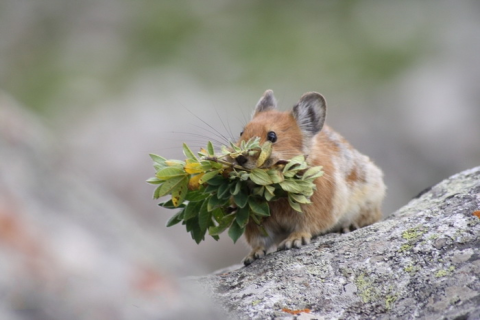
“Pikas” can refer to birds as well as mammals. The mammal ones are small creatures resembling hamsters. However, their closest relatives are hares and rabbits: they are included in the same order, Lagomorphs. Most pikas store hay for the winter (haypiles), which gives them a common denomination of “haystackers”.
One of the subgeni of pikas is the mountain Conothoa. This is one of the few mammals on the planet to inhabit the tallest mountains - the screes and deserts of the high mountain belt of Asia; only two species descend to the forest belt of the mountains. The ranges of most mountain pikas are located near various political boundaries, which makes them difficult to study. As a result, the intraspecific taxonomy (classification) of none of the Conothoa species has ever been studied on the scale of its entire range.
Specialists of the A.N. Severtsov RAS analyzed pika skeletons from the collections of the largest museums in the world. The results of the measurements of the skulls, processed by complex statistical methods, made it possible to find out which of the specimens are indistinguishable from each other, and which, most likely, belong to different species or subspecies. Also, samples of biological tissues and museum specimens were collected for the study in the territory from the Tien Shan to the Sino-Tibetan mountains.
The taxonomic revision showed that the number of species in mountain pikas is less than previously thought. According to the researchers, the number of species was overestimated due to the fact that collections from different regions were stored in different parts of the world. Previously, no one had been able to compare the taxa of pikas with each other.
“We are the first to conduct a study of the intraspecific variability and phylogeny (historical development) of Conothoa pikas. During the existence of the species, some populations move away from others. For example, western from eastern. The speciation begins. After some time, such populations become possible to distinguish. The simultaneous existence of such populations is called intraspecific variability. We also proposed a subspecies division scheme for each species, that is, a list of subspecies that we were able to confirm,” says Andrei Lisovsky, senior researcher at the Mammalian Microevolution Laboratory of the IEE RAS, Candidate of Biological Sciences.
In addition, the analysis of routes and publications of the 19th century made it possible to discover type localities - previously unknown - of some species of mountain pikas. For example, the very first of the described species of these pikas was collected on the Kun-Lun ridge (the border of India and China), but so far no one knew the exact location. Another discovery was that for the four species inhabiting the southeastern edge of Tibet, the narrow-range basal forms were found here.
“Speciation occurs by dividing a species into two groups. For example, geographically. Suppose a river flows between two populations and conditionally divides the species. Or if the population is widely settled, as a result of cataclysms their territories are separated by natural obstructions. Then any group can again be divided into two, and so on. This is how it always happens. Sometimes basal forms are preserved - this is one of the populations formed as a result of the first division into two groups,” explains Andrey Lisovsky.
The research results are published in Zoologica Scripta
Related materials:
Scientific Russia: "Scientists of the IEE RAS for the first time investigated the family ties of
high-mountain pikas."
